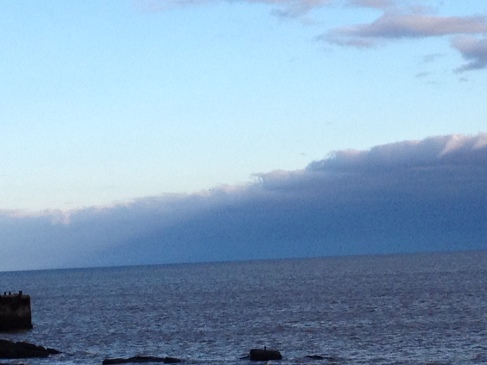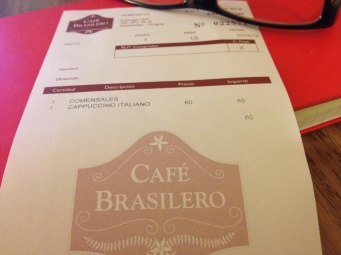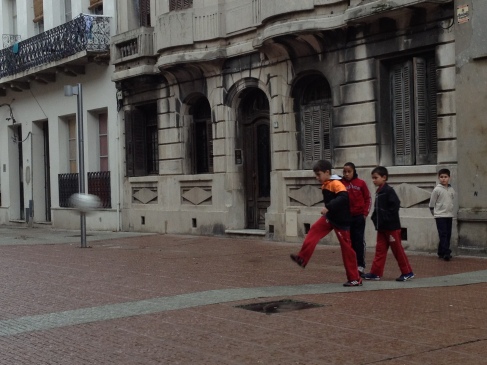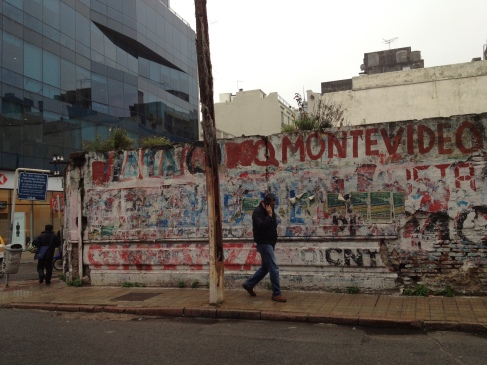A few days ago I travelled from Buenos Aires toMontevideo, the capital city of Uruguay, on a boat during the worst rainstorm I have ever seen. I was sitting in the front of the boat right by the windows. It was impossible to see anything but the drops of water that would violently land on the boat’s huge windshield and then be blown apart and smeared across the glass by the heavy. They looked like a crisscrossing series of watery roads. Luckily the boat was steady and strong, and it felt kind of cozy speeding through the foggy darkness to our destination.
Just like Argentina, Uruguay has experienced revolutions – first for its independence in the early 19th century, and more recently in the 1970s from a military dictatorship. Those revolutions inspired writing that we are going to study together. Although the revolution for democracy in Uruguay happened at a similar time to the one in Argentina, I’m learning that in many ways it was a lot different.
Before I teach you about this country and what happened here, I want to introduce you to Montevideo through the words of one of the great Uruguayan writers, Mr. Eduardo Galeano. He is writer of fiction and non-fiction, and he writes about how important it is for people to remember who they are and where they come from. Most famously he has written about the history of Latin America, and how he feels it is critical for Latin Americans to remember and take ownership of their past. His truthful storytelling meant he was exiled from Uruguay during the dictatorship. He travelled first to Argentina, and he had to leave there, too, for the same reasons. He eventually came back to his city in 1985, and he has lived and worked here ever since.
The poem I want to share with you is about the city of Montevideo and, thankfully for me, it has been translated from Spanish by Mark Fried. It was written this year, and it doesn’t have a title. I illustrated it with a few photos that I have taken over the past few days. Consider this your introduction to the country of Uruguay and its stunning capital city. I can’t wait to tell you more!
Every day I walk the city that walks me.
I walk through her and she walks through me.
At the edge of the river-sea, river as broad as the sea, the clean air clears my mind and my legs stride on while stories walk inside me.
Walking, I write. At a stroll, words seek each other and find each other and weave stories that later on I write by hand on paper. Those pages are never the final ones. I cross out and crumple up, crumple and cross in search of the words that deserve to exist: fleeting words that yearn to outdo silence.
Born on the path of a cannonball, Montevideo is swept by breezes that cleanse the air. Before there was a church or a hospital, this point of rock, earth, and sand had a café. It was called a pulpería, the first house with a wooden door amid the huts of mud and straw. They sold everything there, from a needle and a frying pan to a pack of tobacco, while men sitting on the floor drank wine and told lies.
Practically three centuries later Montevideo is still a city of cafés.
We don’t ask, Where do you live? rather, What café do you go to?
But in the world of our time there is barely time to waste time, and the oldest cafés, the most endearing, don’t deserve to exist because they can’t turn a profit.
I go to the Café Brasilero, which miraculously lives on.
This is the last of the ancient meeting places where I learned the art of storytelling by listening to liars who, by lying, told the truth.
The café was my university.
I never knew the names of those magicians who could make what had never happened happen when they told it. From those masters, from their unhurried speech, their easy stride, I learned while pretending not to, looking out the window at a “Ford with whiskers,” as we called the many Model T’s that cruised the streets of Montevideo at the pace of a tortoise. They still do, inexplicable survivors that can be seen in our city and nowhere else: impassive, haughty museum pieces, indifferent to the vehicles of today which devour at a dizzying pace the hours and the air.
There are those who say Montevideo is a boring city.
Maybe they are right.
Nothing happens here.
Nostalgia wins out over hope.
In a yawn, you can lose two aunts.
But this is also the capital of a country governed by guerrillas released from prison and elected democratically, and it is the city that produces the most experts who philosophize on everything and nothing, the city with the most independent theaters and the most noncommercial moviehouses, including the first to show Bergman and Polanski, the city that celebrates the longest carnival in the world, and the one that produces the most soccer players, because here every baby is born screaming goal.
Montevideo, the city where I was born.
The city where I would be born again.








Wow, What was you favorite place in Montevideo and why?
I found it very different, how the people in these cafe’s told the truth by telling lies, in a twisted way it makes sense. Can’t wait to learn bout these Cafe’s and what they had to do with the Dictatorships of Uruguay.
I agree with dhilexa that in a weird way it makes sense. I like this topic very interesting.
The lines that stood out to me the most were, “This is the last of the ancient meeting places where I learned the art of storytelling by listening to liars who, by lying, told the truth. The café was my university.” because of how he made a connection between the café and a university for the fact that it shows that he learned a lot from these people and this place that evidently means a lot to him. In addition, I think he’s saying there is a message behind the stories that were told even if they weren’t real and that’s what meant something to him. It is interesting to see a place through the eyes and perspective of someone who grew up there.
I enjoyed this poem and I liked how the poem was describing what was being seen. The lines that stood out to me were “Walking, I write. At a stroll, words seek each other and find each other and weave stories that later on I write by hand on paper.” The reason is because I can make a connection to a post I had previously read named ” Hard Words” and how words seem to work together to make something better and stronger. I think that he is saying that his observations are able to make something greater and can be symbolic of his country. Having first hand experiences, he is able to put more emotions and thoughts that someone who lets say just goes there for a visit would. I like how I’m able to feel and imagine what he sees on his walk with the use of sensory imagery.
Between the other articles this really different and how the pictures look so different and how there is some graffiti in the pictures but it lloks different then the other graffiti that we saw in the other pictures. And the cafe is something really big in the countries of latin america
I love this line “Nostalgia wins out over hope.” To me it says that the longing for the past wins over hope of making something better for the future. Its very interesting how Galeano describes the place where he was born and where he grew up. I cant wait to learn more
I love the line ” Every day I walk the city that walks me”. This sort of relates to how I feel with New York City but more of Washington Heights. As much as I say that I need and want to get out of Washington Heights, the Heights lives inside of me because I’ve grown up here. I know this place up and down. This line shows sensory imagery aswell and you can picture something big “walking” inside of someone showing how big the city is in their life.
The line that caught my attention the most was “I walk through her and she walks through me.” I feel as though I walk through the same parts of this city over and over and yet still see the same things with no change and wonder will anything ever change, and then I look at my life and then realize I need a couple of changes and clear my path. I always say I dont know what I want to become, and then I start thinking that I already know what I want to become. My biggest fear is trying to get to what I want to become.
What did you think about he graffiti in Montevideo?
The line that I think was the most interesting one was “Nostalgia wins out over hope”. I think that people spend more time being sad then hoping for something good to happen to them. This stops the people from being happy enough to live a better life. I think that it stops them from doing the think that they like to do, it stops them from being free.
This was a strong poem. I’m a poem writer myself and i think that the way he writes about his city is amazing. He puts the city in his own detailed words. He uses the most of the city to make the poem so wonderful.
I really like this poem its very interesting. The part that i like the most was ” we dont ask ,where you live?, rather what cafè do you go to?”. The quote mean that to them they didnt care most on where people lived but the most important thing was the cafè where everybody enjoy being the most.
I enjoyed this poem because it goes with the pictures displayed, the Poet that wrote this must really care about his home, as in where he lives
This poem itself brings out the truth in a way that expresses the truth in its own unique way. People probably interpret it in many ways but it has a soft smell of home in the sense that the author makes it feel that way with his own feelings and this is now one of my favorite poems.
I personally love this poem written by the amazing yet talented Mr. Eduardo Galeano! I like the way he described he’s city of Montevideo and writing about the things he saw while walking. The line that stood out the most to me was “Every day I walk the city that walks me. I walk through her and she walks through me.” This line stood out the most to me because it reminds me of my neighborhood of Harlem and of Washington Heights where I go to school. The reason is because the more I walk through these areas I never see a change. I always see things exactly how they were before. However I don’t notice the small changes that are going on. These lines make me think that I haven’t change my life or the way of me being. It makes me want to set some goals and change who I am for the better. Also I often say that when I grow up I want to move to different place far from New York City not realizing that NYC is a big part of me, and that I walk through her as she also walks through me.